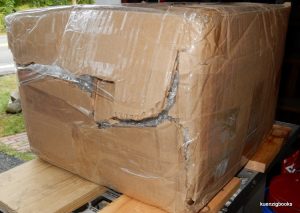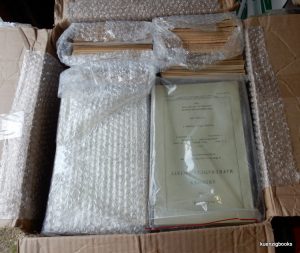I went to the post office today, excited having been notified that a recent purchase had arrived. The post office worker went back to get the box, I could hear the grunting, and they asked me if I could come in back and pick it up. It was a large box full of scientific journals.
My elation became dread. The box had exploded on one side! What had become of my precious tomes? I opened it up quickly:
It turned out I was mostly okay. Phew. But I thought what if this could have been a disaster? It might be worth telling a few of the do’s and don’ts of packaging.
So a few mailing basics for those who might be interested to read them:
- Remember that post office handlers (this goes for all mail services) are people too. If you have trouble hoisting the box, split it in two. Or three. Make it easy to handle, and it will have an easier ride.
- If you are packing something heavy, be sure to pack it in a double weight (or double walled) box. These are cardboard boxes that are designed to take more punishment than the average. Why spend the additional money? Because the mail handler, at the end of a long day, may just chuck your box into the van or pile, not place it carefully like you would. Someone might not know it is heavy and try to lift it and drop it quickly. Remember. Human Beings.
- This leads to a corollary. When you package, assume the worst. Assume your box will get kicked around a bit. Just like driving defensively, I’m a huge fan of packing defensively. This means leaving space around the items in the box. Our standard is roughly 2 inches all the way around unless we’re shipping in a solid box and the item inside is not very heavy.
- Think like the object in the box. Ever watch one of those crash-test dummy videos? The car hits something and the crash-test dummy continues to move in the direction that the car was headed. Often the the crash test dummy hits their head on the dashboard. Similarly, if your box is dropped, the contents will continue to travel INSIDE the box until they come to rest. So packaging around the object MUST be able to absorb shock.
- Use bubble wrap. It can absorb shock pretty well. DON’T USE newspaper. Not only does newspaper compress very quickly, but ink from the newspaper will transfer incredibly easily to the white paper of books. But, you say, the book is wrapped in plastic! Remember, the human being unpacking it will FIRST remove the newspaper (transferring ink to their hands) and THEN open the package. If they’re not careful and very aware, they’ll transfer ink to the book.
- It rains out there. So put the book in something that will repel water. We most often will wrap the inner book in a plastic bag, then wrap it in bubble wrap. Then surround the result in the box with packaging peanuts. Weather proof, shock proof, and a clean presentation.
- Movement is your enemy. If when you’re done packing, you shake the box and the contents move around, you could do a better job. Remember the crash test dummies? You don’t want them to have enough room to be able to move around, and possibly break their neck as well as their head. That’s what extra space in the box does. Give things space to move around, damage your padding, and damage the object in shipment. If you use cheap packing materials, they compress. And create space. Not good.
- ALWAYS include a packing slip in the box. Why? Because in the event your box does get opened for postal inspection, customs, or the tape just falls off or the box does get damaged, having an extra packing slip inside can mean the difference between your book getting to the customer or going into a postal service auction. Contrary to popular belief, postal workers of all types care about getting your packages where they belong. So help them help you.
- Fragile items need MUCH more careful consideration. We’ve shipped Edison era carbon filament light bulbs all over the world. I’ve only lost one in 20 years. That takes careful packaging. We put the bulb in a plastic bag to guard against water. That wrapped in the equivalent of cotton balls for a very soft up close and gentle trip. Then put this in a small inner box. That box is surrounded by paper that has been run through a paper shredder (the kind that creates strips). This can be moved around to make a nice “nest” that is SUPPOSED to allow the inner box to move a little bit. Then fill the outer margins with packing peanuts. If the box gets dropped, there are several layers of shock absorption inside, with less received by the fragile light bulb.
- Help the postal worker help you. LABEL when things are FRAGILE, should be UPRIGHT in a certain direction. Tape your label to the box so it stays with good tape. Not the cheapest on sale kind. Good solid tape. For a few cents per hundred yards more of your packages will get there.
- We’ll end with a pro-trick by our very own packager Sxxxx. When you’re wrapping your inner book with bubble wrap, try using painter’s tape to close it. If it adheres well enough to stay closed it serves two purposes. One: since it’s blue, it’s obvious where to open the bubble wrap. 2) When it comes loose the bubble wrap is re-usable more easily by the customer. If it doesn’t adhere well (often in summer months) then put a strip of blue painters tape on the end of the better sealing tape. Again, more visible about where to open the package.
- Extra tip. Remember that the person opening the package you’ve carefully packaged is using a knife of some sort. So it is often a good idea to put a small piece of cardboard inside a box where they might otherwise slice the book.
So back to our object lesson that appeared today. What did the packer do right? Put things inside in plastic. GOOD! Then in bubble wrap. GOOD! Stack things inside so that there was minimal movement between the items. GOOD!
BUT. Didn’t use enough bubble wrap either between the groups of items, or between the items and the edge of the box. BAD! Didn’t use a double walled box for heavy items. BAD! Didn’t use an internal packing slip. BAD! Packed too much in the box. BAD!
All in all both the seller and I were very fortunate – nothing critical was damaged. We were also lucky that the postal worker taped around the box when they noticed the split before anything came pouring out. I’ve received partial boxes before like this with contents missing. So it does happen. We did end up with some bumped corners, and a bit of a downer to the start of the day. But all in all a good moment for a blog entry.
FWIW, when I called the seller to note the arrival condition, he noted he would refund my money no questions asked, and was apologetic in the extreme (especially I suspect because I mentioned this before he shipped). I will tell him momentarily that all is ok, and no refund is necessary. In this case we BOTH did the right thing – and we both learned something to pass on to the masses.
Pack well, and you’ll never end up in the same situation! Happy bookselling/collecting!



